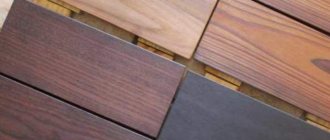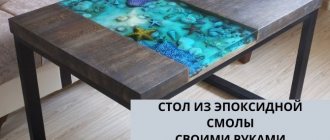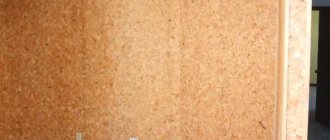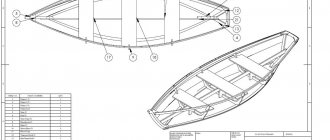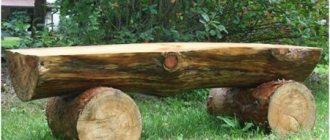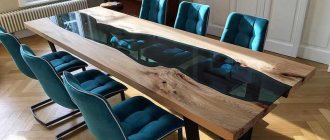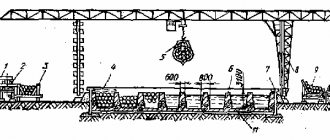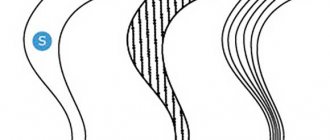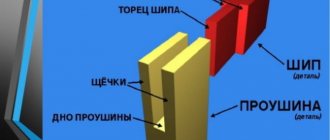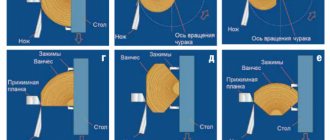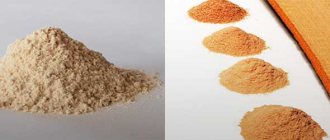Wood impregnated with hot air vapor without the use of chemicals is called thermal wood. The technology makes it possible to obtain a material that is resistant to fire, immune to mold and mildew, and more durable when compared to its untreated counterpart. The technique is successfully used in the manufacture of finishing materials, crafts, and souvenirs, and today I will tell you all about this technology.
Source strport.ru
What is thermowood
A modification of one of the most popular building materials, called “heat treatment of wood,” was first used in Finland. As a result of drying with steam and high temperatures, raw lumber radically changed its physical properties. It was found that after the manipulations, changes occur in the molecular structure of the raw material, and the porosity inherent in wood improves.
The resulting building material is not afraid of water. Moreover, such properties were obtained without the use of special chemical compounds. After heat treatment, the wood becomes immune to temperature changes and does not dry out or crack.
Source drova-darom.ru
In addition, the color of the material changes. The structure of the fibers receives a noble dark shade inherent in expensive types of wood. The improvement in quality parameters becomes more than 15 times higher. At the same time, all the positive properties inherited from wood by nature are preserved. It retains its environmental friendliness, vapor permeability and thermal conductivity.
Historical review
The use of heat treatment to change the properties of wood is not new. Research has been carried out in different countries for several decades. The first high-temperature wood drying process was carried out in 1920. Basically, it was possible to reduce the equilibrium moisture content to prevent swelling of the wood during use.
Subsequent experiments proved that heating raw materials in gaseous atmospheres eliminates the possibility of swelling and shrinkage. Heat-treated wood becomes resistant to the destructive power of fungus without the need for compaction.
Modified wood products did not have much success in the industrial market, likely due to the availability of high quality raw materials at the time.
There was renewed interest in heat-treated wood as a material at the end of the last century. This is due to the deforestation of subtropical forests, increasing demand for sustainable building materials and increasing regulations to reduce the use of toxic chemicals.
Since the 2000s, research has been carried out around the world. The first enterprises opened in the Netherlands, Germany and Finland that began industrially processing lumber using temperature control.
What is the manufacturing technology based on?
The technology for manufacturing thermowood consists of gradually heating its fibers to a high temperature. The goal of the process is to change the molecular structure and improve the characteristics of the material. This cycle consists of several stages:
- The material is placed in a special chamber, where the process of heat treatment and drying of the wood takes place.
- Being under atmospheric pressure, the workpiece is heated to a temperature of 115°C. As a result, abundant steam is released, filling the internal space of the working chamber. Gradually he squeezes all the air out of him.
- The temperature of the sealed volume increases to 150-190°C. The specific value is determined based on the type of wood and the required degree of processing.
- During the thermostatting process, a set excess pressure of 2-4 atm is pumped into the chamber, which is maintained by a vacuum pump connected to the system and held for 5-6 hours.
- After the required period of time has passed, the vacuum in the working chamber is compared with atmospheric pressure. The internal decomposition products and condensate formed on the surface of the workpiece evaporate naturally. Due to this, there is no damage to the workpiece and there is no burning smell.
I emphasize! The values of pressure in the working volume, drying temperature and cycle time may vary, I have presented them in an average version.
Color spectrum
Color is an important property for the end user. In some cases, it is the main factor for choosing a particular wood based on aesthetic considerations.
Darkening during processing is an important advantage, giving the wood a valuable aspect in some countries. The color change, even black, is due to the breakdown of hemicellulose, extractive substance components and the formation of oxidation products such as quinones.
Since the wood is treated evenly over the entire surface, the color is also distributed organically. Shades can be very different, from light sand to deep brown and even black.
Classification
There are 3 methods of heat treatment of wood-based materials. They differ in the method of steam treatment:
- The above-mentioned single-stage, in which a constant value of the loads is maintained.
- Another method is multi-stage heat treatment. This implies a periodic change in the value of steam pressure. This option is even higher quality and helps to obtain better protective properties.
- The production of premium thermowood is carried out by treating with nitrogen (instead of steam). Products obtained in this way are classified in the highest price category.
Source moscow.tuzlist.ru
The classification of sold heat-treated wood is as follows:
- First grade. The wood is kept at a temperature not exceeding 190°C. The result is weak, the fiber structure slightly changes color.
- Second class. The operating temperature is 210°C. Indicators of wear resistance and resistance to decay processes increase. The dark shade becomes more noticeable.
- Third class. Heat treatment of wood is carried out at temperatures up to 240°C. The color becomes dark, the quality characteristics of the material rise almost to the maximum level.
Source wooden-city.com
I emphasize! Check with the seller what class the material you are interested in belongs to. Its cost and quality depend on this.
Advantage of Heat Treatment
I have told you in general what thermowood is, now let’s analyze what the main advantages of such a material are. I would highlight:
- Strength. Heat treatment reflects on the wood a more durable surface compared to untreated wood. The modified structure is able to withstand significant loads, is not subject to deformation after a long time, and is not so susceptible to mechanical damage. As a result, it retains its original appearance for a longer time than its unprotected counterpart.
- Moisture resistance. The treated material practically does not absorb moisture. The wood does not swell and does not lose its original shape even when used in rooms with high air humidity.
- Immunity to fungus and mold. As a result of thermal exposure, wood sugar, which attracts microorganisms, is removed from the pores along with moisture. This provides additional protection against harmful bacteria that cause wood rot.
- Aesthetics. As already mentioned, wood that has undergone heat treatment takes on a darkish tint. This emphasizes the contrast of the natural material, making it more expressive.
- Fire safety. Heat treatment makes the fiber structure stronger. They contain less oxygen, which reduces the likelihood of fire.
Source worklad.co.uk
I emphasize! All these criteria characterize an increase in the service life of materials.
Making a clamp clamp
The key to making a tight bend is to use a flexible clamp. Make a clamp from mild steel, 2mm thick and at least as wide as the workpiece you bend. This will work for almost any job you might need to do. To avoid possible contamination of the surface of the part as a result of reactions between the chemical elements of wood, metal and the environment, make the clamp from stainless steel or galvanized steel or use a polyethylene gasket.
Install end stops or stops on the clamp to secure the ends of the workpiece, thereby preventing the fibers on the outside of the curved part from stretching and delaminating. These stops must be strong enough to withstand significant pressure on them, and be of sufficient size so that the end of the workpiece can rest against the stop with its entire surface. You can make them from thick angle metal or from solid wood, which is usually easier to do.
To equip the clamp with reliable end stops, install wooden blocks approximately 225 mm long at the ends of the metal strip. Along the center lines of each block, drill two holes with a diameter of 9 mm at a distance of about 150 mm from each other. Mark and drill the clamp strip for the end stop mounting bolts. The distance between the stops must be equal to the length of the workpiece, including the allowance. To ensure that the clamp has a lever action that is convenient for operation, attach sufficiently strong wooden blocks to the ends of the strip on its back side using long bolts for fastening the stops.
Making a template
Steamed wood is bent into a pattern that defines the shape of the bend and provides support for the fibers of the interior of the curved piece. The template must be very strong and have a width that is at least equal to the width of the part being bent. It must provide certain possibilities for fixing the workpiece on it using clamps or other clamps.
You can make a template from thick wood, setting the mold on a base made of artificial wood materials, or use sheets of plywood glued together. Because bent wood tends to straighten after the clamp is released, it is necessary to adjust the shape of the template to account for the straightening of the part. To do this, you will have to use the most reliable, although not always pleasant, method - trial and error to determine the parameters of such correction.
Types of wood for bending with steaming
- Ash Fraxinus excelsior Fraxinus amcricana
- Beech Fagus grandifolia Fagus sylvatica
- Birch Betula pendula Benda alleghaniensis
- Elm Ulmus americana Ulmus procera Ulmus liollandica Ulmus thomasii
- Hickory Cartja spp.
- Oak Quercus rubra Quercus petraea
- Nut Juglans nigra Juglans regia
- Yew Taxus baccara
Making a steam chamber
Make a steam chamber from plywood for outdoor use or use plastic or metal pipe boxes. Plywood allows you to create a simple structure using glue and screws exactly to your specific requirements. This type of chamber is ideal if you plan to steam entire batches of wood. A chamber made of plastic or metal pipe limits the size range, but is quite suitable for small workpieces.
Cut a piece of pipe to the required length in accordance with the dimensions of the workpiece. The length of 1 m is a convenient size that allows you to process entire workpieces or even parts of increased length if you need to bend only its end part. Make removable push-in end flaps from plywood for outdoor use. Drill a hole in one of them for the steam pipe and use a plane to plan the lower part of the edge of the other damper to create ventilation and a drainage hole. Make special “open” flaps with a hole for long workpieces. Place wooden supports inside the corpses so that the workpiece does not touch the bottom of the chamber. Insulate the chamber using polystyrene foam or wooden blocks, securing them to the chamber with wire. Place the camera on stands with a slight inclination to allow condensation to drain out. Provide a receptacle for any leaking water.
Steam can be obtained using a small electric evaporator or a factory-made steam generator, or you can make your own evaporator from a 20-25 liter metal tank with a removable lid or cap. Connect one end of a short rubber hose to a pipe or valve (valve) soldered into the tank, and insert the other into the hole in the chamber damper. To heat the water, you can use a heating device, such as an electric or gas stove. Fill the tank halfway with water and heat it to 100 °C. to ensure a constant flow of steam. As a guide, wood should be steamed for 1 hour for every 25 mm of thickness. Longer steaming will not necessarily improve the ductility of the wood, but may destroy its internal structure.
Flaws
Despite the abundance of positive qualities, heat treatment of wood fibers has a number of disadvantages that must be taken into account. I would point out:
- Heat treatment of wood is a technology that makes the fiber structure harder. Simultaneously with this parameter, fragility also increases, so if handled carelessly (for example, driving a nail), the workpiece may simply crack. To avoid cracking, I recommend drilling preliminary holes.
- The material becomes more sensitive to ultraviolet radiation. To maintain its original appearance, it will have to be periodically tinted or treated with special compounds.
Source yandex.net
I emphasize! The technique has not been sufficiently studied and it is not known how it will behave during prolonged stay in the soil. Therefore, I do not recommend using such wood as poles.
Properties
Heat-treated wood is non-toxic and therefore has no restrictions on its use. The degree of improvement in strength class is from 5 to 2, the indicator is influenced by the level of impact during the production process. The lower the coefficient value, the more suitable the selected heat-treated wood is for use in open spaces and is more durable in contact with the ground.
But this improvement occurs at the expense of loss of mechanical properties. The tree becomes brittle. At the same time, heat-treated wood has reduced hygroscopicity and improved dimensional stability.
The thermal insulation capacity of heat-treated wood increases by a third.
Surfaces are poorly bonded due to their compact size and reduced hygroscopicity.
Heat-treated wood lends itself well to painting with any varnishes and paints.
How to heat treat wood at home
The production of thermowood is a process that requires specialized equipment. However, you can set up handicraft production at home. To do this you will need the following:
- A hermetically sealed container that can block the internal volume from atmospheric air.
- Source of thermal energy. For example, it could be a heating element, gas or solid fuel heater. It is necessary to organize its operation in such a way that high-quality heating of the internal volume of the working chamber is carried out.
- A container with water designed to pump a given humidity.
Source trmd.ru
The principle of operation of the device is to place the above-mentioned container in the chamber. As a result of heating, the evaporation process will begin, which will prevent the wood from burning. This is also facilitated by the lack of oxygen, which is displaced by hot vapors.
Source maiso.ru
Such devices are found quite often and are made from any available materials. For example, railway tanks, agricultural metal barrels, or homemade welded boxes can be used as a sealed volume.
Where is thermowood used?
Thermowood is used in any area where regular wood can be used. In many cases, thermowood is chosen for finishing rooms with high humidity and unstable temperature conditions. The products are ideal for finishing facades and street terraces.
The noble texture and pleasant shade allow you to replace expensive materials.
Professional construction workers prefer to choose thermowood for finishing:
- Baths and saunas;
- External and internal finishing works;
- Production of window and door structures;
- Construction of stairs;
- Production of flooring;
- Creation of furniture paraphernalia;
- Production of landscape structures;
- Formation of fences;
- Manufacturing of musical instruments;
- Production of souvenir elements;
- Decorative finishing for sea vessels, yachts;
- Restoration of buildings.
When choosing a finishing material, you must take into account its size and thickness. In the home and construction departments you can find more than 20 varieties of thermowood, which are intended for different applications.
The old way
The simplest and most proven method of making thermowood (in my opinion) for home crafts:
- I lower the workpiece into boiling water and let it sit for 1.5-2 hours.
- I take it out, wipe it dry and wrap it in thick cloth.
- I place the bundle near a heat source and let it sit for several days.
I emphasize! Using this method, ancient woodcarvers strengthened the structure of soft linden products.
Source blogspot.com
